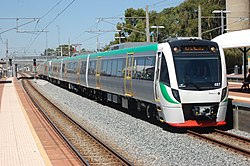Railways in Perth, the capital city of Western Australia, have existed since 1881, when the Eastern Railway was opened between Fremantle and Guildford. Today, Perth has eight Transperth suburban railway lines and 85 railway stations.
The Transperth network is owned and operated by the WA Public Transport Authority (PTA) and consists of eight lines: the Airport, Armadale, Ellenbrook, Fremantle, Mandurah, Midland, Thornlie–Cockburn, and Yanchep lines. Perth's trains had 53.2 million boardings in the 2022–23 financial year, giving the Transperth rail network the third highest patronage out of all of Australia's suburban rail networks. [1]
A notable feature of Perth's urban rail network is that a significant portion of it operates in the median of freeways, with dedicated bus-train interchanges and extensive Park & Ride (P&R) facilities provided at certain stations. [2] [3] Passengers arrive on feeder buses or use P&R and transfer to trains at railway stations. These system design features are a response to Perth's low density. [2] [4] [5] [6] [7] [8]





















